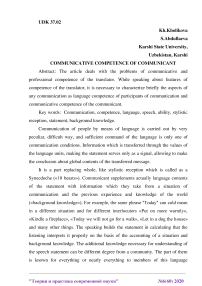Communicative competence of communicant
Автор: Kholikova Kh., Abdullaeva S.
Журнал: Теория и практика современной науки @modern-j
Рубрика: Основной раздел
Статья в выпуске: 6 (60), 2020 года.
Бесплатный доступ
The article deals with the problems of communicative and professional competence of the translator. While speaking about features of competence of the translator, it is necessary to characterize briefly the aspects of any communication as language competence of participants of communication and communicative competence of the communicant.
Communication, competence, language, speech, ability, stylistic reception, statement, background knowledge
Короткий адрес: https://sciup.org/140275518
IDR: 140275518 | УДК: 37.02
Текст научной статьи Communicative competence of communicant
Communication of people by means of language is carried out by very peculiar, difficult way, and sufficient command of the language is only one of communication conditions. Information which is transferred through the values of the language units, making the statement serves only as a signal, allowing to make the conclusion about global contents of the transferred message.
It is a part replacing whole, like stylistic reception which is called as a Synecdoche («10 beasts»). Communicant supplements actually language contents of the statement with information which they take from a situation of communication and the previous experience and knowledge of the world («background knowledge»). For example, the same phrase "Today" can cold mean in a different situation and for different interlocutors «Put on more warmly», «Kindle a fireplace», «Today we will not go for a walk», «Let in a dog the house» and many other things. The speaking builds the statement in calculating that the listening interprets it properly on the basis of the accounting of a situation and background knowledge. The additional knowledge necessary for understanding of the speech statement can be different degree from a community. The part of them is known for everything or nearly everything to members of this language collective, others are known only to the people of a certain profession possessing special preparation, the third are the general only for a small social, territorial or family group of persons. The ability of the person to an inferential – to the formation of the correct conclusions about their full contents or "sense" on the basis of background knowledge - makes its communicative competence of speech statements.
As it was already specified, speech communication is carried out via statements and texts. The language units, making the text actors in it in the contextual values which are formed on the basis of their values in language and a context of their use in the text. Set of contextual values of the units of the statement in their interrelation makes the plan of the contents of the statement. The language contents of the statement can hand over information explicitly, that is, through values of language units, or implicitly, through the additional sense connected with these values in consciousness of speaking collective. In this regard the speech acts creating statements, can be direct or indirect. So, whether a question «Can you close a door? » means a request it to make and the phrase «I at a wheel» can mean «To me it is impossible to drink alcohol».
The main thing in the sense of the statement is an intention of the sender (the author, information source) to make that message for the sake of which he created speech work.
The intention of the author defines contents of the statement and its sense, but can be realized in them with different completeness and is more or less successful. Therefore, the author's intention deduced from the contents and the sense of the text can correspond indifferent degree to a subjective plan of the author.
For transfer of more difficult messages a number of statements unite structurally and semantic in a whole – the text. The text – communication unit – can consist and of one statement. For ensuring integrity of the text various means of semantic and formal communication are used. Ways and means of registration of structure depend on a text type and character of transferring information .
There are the standard types of the texts which are under construction on accepted schemes, and the non-standard types of texts possessing rather free structure. The separate text can correspond in various degrees to the type (prototype).
Ability to create texts of various types according to a communicative task and a communication situation to provide appropriate structure of the text, to use language text units by rules of creation of speech units in language, to estimate a place and a ratio of separate parts of the text and to perceive the text as the coherent speech whole make text forming competences of communicant.
Professional competence of the translator includes also some personal characteristics without which it cannot successfully carry out the professional functions.
Список литературы Communicative competence of communicant
- Theoretical aspects of linguistics of transfer //Problems of the theory and a transfer technique in higher education institutions of republic: Theses of reports of republican scientific and methodical conference. - Tashkent, 1982.
- Naturalness art translation.//Literature and translation: Theory problems. - M, 1992.
- To the definition of the concept "transfer"//Educational and methodical development to a course of the theory of transfer.- M: МGPIFL of M. Thorez, 1972.
- Translation as object of linguistic research.//Questions of the theory of translation in foreign linguistics. - M: International relations, 1978.


